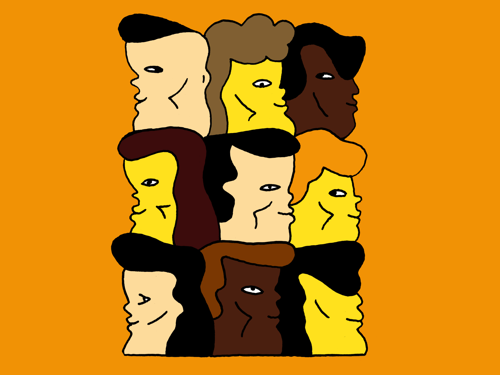Reinventing Organizations by Frédéric Laloux
Feb 12, 2020
6 mins


Discover our series of HR MustReads. Our goal is to help those who make up the workforce of organisations keep their minds open to the best of what’s written on their craft. HR is such a large subject that our MustReads include a wide variety of inspiring books about organisations, management, recruitment, employment, and even anthropology, sociology and psychology!
Our episode 3 is dedicated to the organisations of the future. Discover our abstract of Frédéric Laloux’s Reinventing Organizations: A Guide to Creating Organizations Inspired by the Next Stage of Human Consciousness (2014) to understand how different organisational paradigms have evolved together with human consciousness and how we can produce more meaning and fulfillment at the next stage.
Reinventing Organizations: A Guide to Creation Organizations Inspired by the Next Stage of Human Consciousness
Reinventing Organizations was published in 2014. It instantly achieved ‘cult’ status: the word was spread by all the HR movements that champion the “liberation” of companies. But the book doesn’t just target the initiated few who already know about “liberated” organisations. It also offers a fascinating history, evolutionary theory and typology of organisations that can help anyone get useful perspective on modern management. Laloux’s work can help understand the gap there can be between an individual and the organisation he / she belongs to, when they operate under different paradigms. The book explores the growing malaise of individuals in organisations.
The way managers work today is increasingly obsolete. More employees than ever before feel disengaged from their companies. Large organisations are stifled by bureaucratic processes and have become largely incapable of change. Employees waste a lot of their time in useless meetings and pointless paperwork that leaves them frustrated and unhappy. We all look for more meaningful workplaces, community, purpose and authenticity. We want to bring all of who we are to work. Not only do we need more enlightened leaders, we also need different structures and practices that allow for meaning and purpose.
Frédéric Laloux was trained as an engineer in Brussels. He obtained an MBA from INSEAD and then graduated from a coaching school in Colorado. He worked for 10 years in an international strategy consulting firm before he became an independent corporate coach. In 2014 he self-published Reinventing Organizations in English. More than 100,000 copies have been sold in a little over two years. The book was translated into many different languages, including French in 2015.
The aim is to help produce more meaning
Frédéric Laloux aims to convince the reader that a new species of organisations is possible that matches a higher level of consciousness. Most organisations today operate under limitative managerial paradigms. But only by offering new models can the old ones be made redundant. Laloux quotes American futurist Richard Buckminster Fuller: “You never change things by fighting the existing reality. To change something, build a new model that makes the existing model obsolete.”
Our internet age accelerated the development of distributed intelligence and the decline of old-style hierarchy. Today we ought to change our value system and invent new ways to work more meaningfully. Everyone can sense that current organisations have reached their limits. A lot of them produce a feeling of uselessness and emptiness. They make their employees unhappy, not only those at the bottom of the pyramid. At every level of the pyramid there is vacuity!
We have reached a stage where we often pursue growth for growth’s sake, a condition that in medical terminology would simply be called cancer.
How can organisations produce meaning and avoid cynicism? Laloux observed 12 pioneering organisations that have succeeded in creating a new more meaningful work model. They can inspire all the others because they aren’t based on a purely theoretical model or an inaccessible utopia. They provide us with very concrete ideas to help push our organisation forward and embrace the next evolutionary step.
A historical typology of organisations: Laloux’s paradigms
Throughout history, the types of organisations that have been invented have always matched the dominant worldview and level of consciousness.
- Impulsive Red is the first organisational paradigm. These organisations are based on arbitrary violence. One leader exerts unlimited predatory power. The paradigm was dominant in the age of empires and kingdoms. It can still be found in mafias and gangs. It is necessary in hostile environments but rapidly faces limits in stable and complex environments. The symbol of the Impulsive Red paradigm is the wolf pack.
- Conformist Amberis the second paradigm. It is based on a strict moral code, law, order, stability and predictability. It was developed to implement vast ambitious long-term projects, like the construction of cathedrals and colonial empires. Today you can find this paradigm in religious institutions, government agencies, the school system, and the army. It represents vast improvement over the previous model because it’s possible to plan ahead and implement stable large-scale processes. These very hierarchical organisations are led by a paternalistic figure. Their main limit is their rigidity: employees aren’t allowed to think or breathe outside the box. The model is il-suited in changing environments. Its symbol is the army.
- Achievement Orange, the third paradigm, emerged during the Enlightenment period and spread fast during the industrial revolution. It is based on efficiency, materialism, and science. Most of today’s large organisations operate under the Achievement Orange paradigm. Its main advantages are innovation, an objective-based management that leaves more freedom in the means to achieve the objectives, and meritocracy. But it also has limits: it doesn’t take the impact of production into account—pollution and inequality, for example. Most of all these organisations fail to produce individual and collective meaning to those who belong to them. The symbol of the Achievement Orange paradigm is the machine.
- Pluralistic Green, the fourth paradigm, promotes harmony, justice, cooperation and consensus. We owe the abolition of slavery and religious liberty to the emergence of this paradigm. It became increasingly popular in the 1960s with the development of non-profit organisations. But today some for-profit organisations also identify with this paradigm. It is based on power sharing and the empowerment of employees, a company culture based on shared values, an inspiring mission, and the full integration of all stakeholders (not just shareholders). But these organisations are trapped in a paradox: they pretend to defend equality but think of themselves as superior. Often they don’t offer viable alternatives to Orange-type organisations. The symbol of the Pluralistic Green paradigm in the family.
- Evolutionary Tealis the last paradigm. It is only in its infancy today. It is the objective to which we strive. While the other paradigms were all based on the idea that resources are scarce, Evolutionary Teal relies on trust and abundance. It matches the next stage in the evolution of human consciousness. When applied to organisations, the paradigm views the organisation as an independent force with its own purpose, and not merely as a vehicle for achieving management’s objectives. These Teal organisations are self-managed. Like the cells of a living organism they function autonomously. Individuals bring all of who they are to work, including their emotions, weaknesses and intuition. Individuals find an identity in these organisation but don’t feed their egos. They have a purpose. The symbol of Evolutionary Teal is the living organism.
Let’s do away with all the preconceived ideas about liberated firms
We tend to think that liberated firms have no structure, no leadership and no management. Nothing could be further from the truth. You need inspiring leaders to share a strong vision. Purpose does need some kind of structure too. There is no perfect equality in liberated companies. The members don’t have to all agree for a decision to be made (which would imply endless meetings). In reality, liberated “Teal” organisations need structures and practices that empower the most competent and motivated people to be in charge in a given situation.
Organic and natural hierarchies replace the fixed pyramidal hierarchy of the other organisations. Clear and structured processes are necessary to make individual autonomy possible and to ensure harmonious collective efficiency. There is no one best way to achieve that. Each company must find its own method, which will depend on its history, culture, assets and specific challenges. In other words, there is no template: all the Teal organisations are unique. They also change constantly: adjustments and modifications are made all the time to better serve the organisation’s purpose.
A few contemporary examples of Teal organisations
Frédéric Laloux studied 12 ‘Teal’ organisations that operate in different sectors and countries. He describes the way they work in detail so the paradigm can no longer be said to be utopian and unrealistic. They all partially (or totally) did away with managers. Centralised support functions are very small.
Here are two of the twelve examples listed in the book:
- Buurtzorg is a Dutch home care provider. The dominant companies in the sector have fragmented work to make nurses more productive, depriving them of meaning and freedom. By contrast, Buurtzorg’s nurses organise their work autonomously. They treat the same patients over long periods of time, spend time with them and find meaning in their work. Self-managed teams of 10 to 12 nurses operate without a boss and decide how to conduct their work. If necessary they can rely on the help of regional coaches, but these have no power over them. The patients cared for by Buurtzorg are healthier and happier. Buurtzorg’s model has proved so successful that it has inspired many other companies over the world.
- FAVI is a medium-sized French industrial company specialised in pressure die casting. It produces car parts for large car companies and other parts for other industries. The company was created in 1957. In the 1980s, the company was transformed into a customer-focused company. New autonomous and responsible teams supplanted the old structure. The company’s values include “love for the customer”, “trust in innovation”… Favi is a first-generation liberated company. It has been studied by several generations of management gurus.

More inspiration: Laetitia Vitaud
Future of work author and speaker

Age does matter, at work and in the White House
What we've learned from the 2024 presidential elections about aging at work.
Sep 09, 2024

Can companies avoid a brain drain as retirements surge?
Bye bye, Baby Boomers. Hello, knowledge exodus?
Jun 12, 2024

Workplace anxiety: Navigating the future of work in an anxious world
Anxiety has taken center stage in our modern world. How is it shaping the future of work? And most of all, what can we do about it?
May 20, 2024

Why recruiters should hire more ex-freelancers
While freelance and salaried work can seem worlds apart, they may have more in common than you think.
May 02, 2024

How women over 50 are reinventing their careers and the future of work
Women in their 20s struggle to be taken seriously, while middle-aged women battle discrimination... So how are women over 50 reinventing the wheel?
Apr 02, 2024
Inside the jungle: The HR newsletter
Studies, events, expert analysis, and solutions—every two weeks in your inbox

